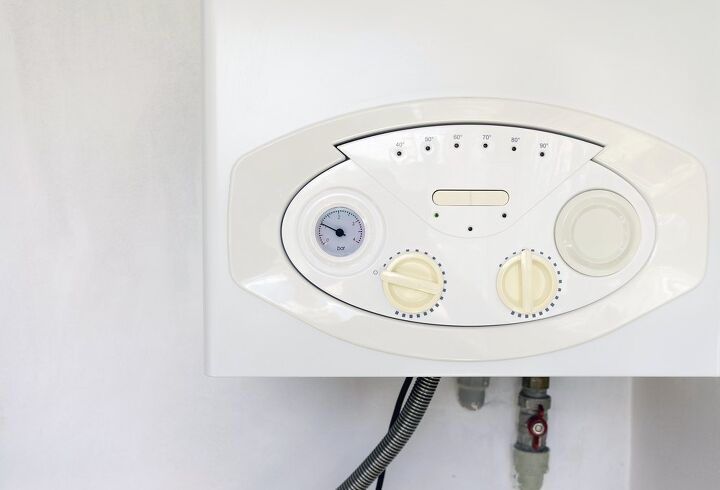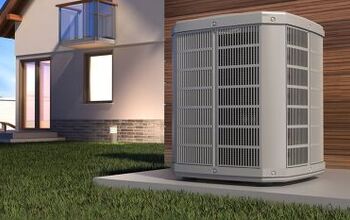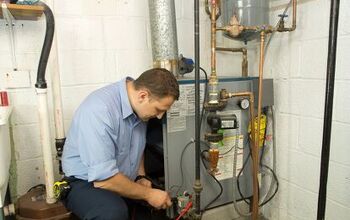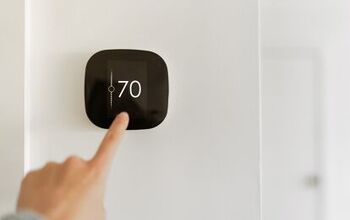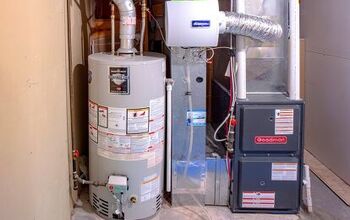Furnace Not Blowing Hot Air? (Possible Causes & Fixes)

Your furnace has one job: blowing hot air. If your furnace is not doing that, what are you paying it for? To address this issue, we’ve come up with some common reasons your furnace may not be blowing hot air.
Clean the air filter and flame sensor so that they ensure that your furnace blows hot air. You can also clean your air ducts with a specialized vacuum and brush to remove obstructions. Replace your blower motor if it isn’t blowing hot air or it makes weird noises when it runs.
Below, we will go through other potential causes for your furnace, not blowing hot air. We will also go through some troubleshooting steps you can follow to pinpoint the issue.
Do You Need a Heating and Cooling Contractor?
Get free, zero-commitment quotes from pro contractors near you.

Why Is My Furnace Not Blowing Hot Air?
There are a few different reasons your furnace could be malfunctioning. The various causes are below:
- Dirty flame sensor, air filter, or furnace
- Poor ducting airflow
- The furnace blower fan is going out
- The pilot ignitor and light are not working
- Faulty thermocouple or gas valve
- Excess moisture
- Error in thermostat
Before cleaning or going through any repairs, be sure that you turn off the furnace circuit breaker. Not doing so may electrocute you. Also, be sure to give the furnace ample time to cool down before cleaning or repairing.
Dirty air filter, flame sensor, furnace
Ask yourself the last time you cleaned your furnace. If you don’t know the answer to that question, there’s no shame, as a heater is one of the more forgettable areas to clean in your house.
Your first step is to check any dirty area of the furnace. This cleaning includes the flame sensor and air filter, as the loss of both of these can cause your hot air to turn into cold air. Get into the habit of checking your air filter once a year. Adding it to a regular cleaning schedule, replacing the filter, and cleaning your furnace will come naturally.
Poor Ducting Air Flow
Next, ask yourself the last time you checked on the ducting system. Again, this is another pretty forgettable area in your household. Also, it is one of the more painful areas to clean in your house.
Given that most air ducts are lengthy and complicated, you will need to hire an HVAC technician. Unless you plan on starting your own business, the specialized vacuums and brushes required to do this are pretty expensive. As a result, it is typically more cost-effective to hire a specialist.
The Furnace Blower Motor Is Going Bad
Unfortunately, a good cleaning doesn’t fix all issues. Sometimes, you have to recognize when parts of your furnace are going bad. When it comes to moving hot air, one of the more common issues come from the blower motor.
The blower motor controls the fan, which pushes the air throughout your ducting system. Once you’ve finished cleaning this area, you need to listen for your blower motor. Here are some common signs of your blower motor going bad:
- Weird noises
- Old systems
- Repairs often
- Short cycling (stopping as soon as it starts)
- High energy bills
If your furnace is older, this typically means that it is time for you to replace it. If your furnace is newer, check online to see if this is a common issue. Otherwise, whoever hooked the heater may have done so improperly.
The Pilot Igniter And Light Are Not Working
Whether it be a pilot light or igniter, either of them not working is a sign that you might have to make a replacement. If your furnace is blowing out cool air, this is a likely cause of it.
First, check to see if your airflow is “too good.” If a stiff breeze disables your heater, that means you likely have an exposed firebox. It is a significant problem for those who live in trailer houses, as there is little protection available in a manufactured home. If there is no apparent reason for your igniter and light going out, the breeze may be coming from your ducting. At this point, it would be wise to hire an HVAC specialist to find the source.
If the heater is not igniting, you may have to replace it. If you do replace it, be sure to avoid touching the igniter with bare hands. The oil on human hands is flammable, which will reduce the shelf life of your igniter. If the pilot light doesn’t stay lit, that may be a sign of the thermocouple going out.
Faulty Thermocouple Or Gas Valve (Gas Furnace Only)
A gas furnace releases gas through a valve, which is controlled by a thermocouple. If either of those is not functioning, your warm air will not convert well into warm air. If the gas valve is not working, the flame you would typically see would not appear from all. It can also mean that the communication mechanism that tells the gas valve to open is not functional.
Look to see if any gas valves look rusted or corroded. If they do, it will be time for a replacement. If they don’t, you will need to contact an HVAC technician to address further concerns. If the fire starts but doesn’t maintain, it is a sign of your thermocouple not working. Don’t immediately jump to a replacement though, try and adjust it using a wrench first.
Excess Moisture In Furnace
Two things cause extra moisture in your furnace:
- Improper ducting
- Faulty condensate line
Improper ducting means that some nearby, moisture-producing object is causing humidity in the duct. In this case, you may have to consider relocating the vent or checking on the insulation.
Improper ducting can also cause the warm, moist air from your furnace not to go anywhere. As a result, built-up condensation will overpower the condensate line and short out your furnace. This situation typically requires a specialist to come to look at your vents.
If the condensate line itself is not working, you may have to check for blockages. These are typically PVC pipes, so they do much like any other pipe. If you feel comfortable with removing it, you can choose to saw it off or try and loosen it. If you plan on sawing it down, be sure you have a replacement pipe handy. Also, be prepared for the excess liquid to come out of the line.
Error In Thermostat
If your furnace is non-responsive to changes in temperature, you likely have a thermostat error. Given that this is an electronic issue, this brings up an entirely new line of troubleshooting steps. Follow this quick set of troubleshooting steps if you believe this is a potential issue:
- Turn off power
- Remove cover and clean inside
- Check for corrosion
- If you have a mechanical thermostat, be sure that your thermostat is balanced
- Replace the cover
- Configure the thermometer
- Check to see your thermostat is in an optimal location
The most common thermostat issues come from lack of cleaning. Temperature sensors on the inside will not work if there is too much dust. While cleaning, check to see if you find any red, rusty bits. Rusted wires will not communicate well with the thermostat. Clean them if possible, but be ready to replace them.
If you have an old-fashioned mechanical thermostat, be sure that it is balanced. Old mercury models that are unbalanced will have the liquid on one side, making it impossible for them to properly track the temperature. If you have the budget for it, now would be a great time to replace the thermostat.
When finishing up, be sure to check the thermostat with another thermometer that is confirmed to work. If it is a few degrees high, that means your thermometer is working correctly. When doing this, be aware of the location of your thermostat. Some of these thermostats are in rooms that are naturally cool or warm. If possible, you may want to try and move your thermostat.
Do You Need a Heating and Cooling Contractor?
Get free, zero-commitment quotes from pro contractors near you.

What If My Electric Heater Is Not Working?
Electric heaters are becoming more common every day. If you live in a house with an electric heater, you will have to prepare yourself for the unique issues that come with owning an electric heater.
Modern electric heaters typically have smart features. As a result, many of those features cause dumb issues. Most time, you can fix those issues by turning them off and back on again. You can do this from the circuit breaker or the heater. The second most common issues come from blown fuses. In this case, you will want to look at the fuse to see if it is still there. If it is, your issue may be more complicated and require an HVAC technician.
Much like gas heaters, they still can overheat or short out due to excess moisture. To solve overheating issues, be sure to be thorough with your cleaning efforts. To solve additional moisture issues, keep your eyes open on duct blockages and other moisture-producing appliances. Much of the same logic applies to both electric and gas heaters. Both of them have fans, but only gas heaters have pilot lights and gas valves.

I'm a guy who becomes the expert of whatever I stumble upon, writing-wise. I've written tons about cool home products, home improvement, and smart technology in the home. I'm also the proud father of a kiddo born on new years, making my holidays very busy.
More by Eli Smith



